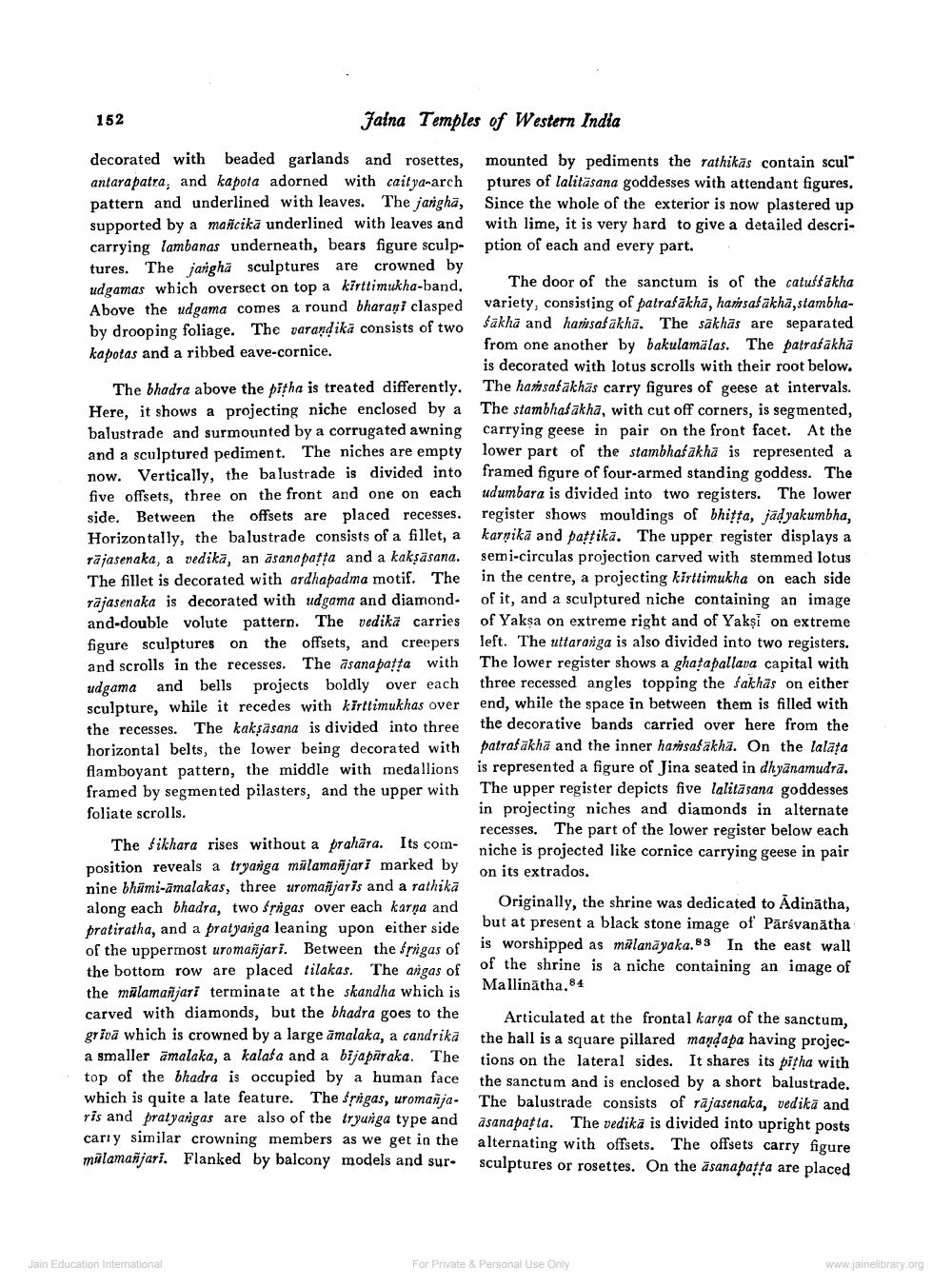________________
152
Jaina Temples of Western India
decorated with beaded garlands and rosettes, mounted by pediments the rathikas contain sculo antara patra, and kapota adorned with caitya-arch ptures of lalitäsana goddesses with attendant figures. pattern and underlined with leaves. The jangha, Since the whole of the exterior is now plastered up supported by a mañcikā underlined with leaves and with lime, it is very hard to give a detailed descricarrying lambanas underneath, bears figure sculp- ption of each and every part. tures. The jarigha sculptures are crowned by udgamas which oversect on top a kirttimukha-band. The door of the sanctum is of the catustakha Above the udgama comes a round bharani clasped variety, consisting of patrašakha, hansafakha, stambhaby drooping foliage. The varandikā consists of two Sakha and hansas akha. The säkhās are separated
from one another by bakulamalas. The patrašakha kapotas and a ribbed eave-cornice.
is decorated with lotus scrolls with their root below. The bhadra above the pitha is treated differently. The hamsašākhas carry figures of geese at intervals. Here, it shows a projecting niche enclosed by a The stambhašākha, with cut off corners, is segmented, balustrade and surmounted by a corrugated awning carrying geese in pair on the front facet. At the and a sculptured pediment. The niches are empty lower part of the stambhafakha is represented a now. Vertically, the balustrade is divided into framed figure of four-armed standing goddess. The five offsets, three on the front and one on each udumbara is divided into two registers. The lower side. Between the offsets are placed recesses. register shows mouldings of bhitta, jadyakumbha, Horizontally, the balustrade consists of a fillet, a karnikā and pattika. The upper register displays a rājasenaka, a vedika, an asana patta and a kaksāsana. semi-circulas projection carved with stemmed lotus The fillet is decorated with ardhapadma motif. The in the centre, a projecting kirttimukha on each side rājasenaka is decorated with udgama and diamond- of it, and a sculptured niche containing an image and-double volute pattern. The vedikā carries of Yaksa on extreme right and of Yakși on extreme figure sculptures on the offsets, and creepers left. The uttaranga is also divided into two registers. and scrolls in the recesses. The asana patta with The lower register shows a ghatapallava capital with udpama and bells projects boldly over each three recessed angles topping the fakhas on either sculpture, while it recedes with kirttimukhas over end, while the space in between them is filled with the recesses. The kakşasana is divided into three the decorative bands carried over here from the horizontal belts, the lower being decorated with patrašakha and the inner hansašākha. On the lalata flamboyant pattern, the middle with medallions is represented a figure of Jina seated in dhyanamudra. framed by segmented pilasters, and the upper with The upper register depicts five lalita sana goddesses foliate scrolls.
in projecting niches and diamonds in alternate
recesses. The part of the lower register below each The Sikhara rises without a prahāra. Its com-
niche is projected like cornice carrying geese in pair
ni position reveals a tryanga mālamasjari marked by on its extrados nine bhūmi-āmalakas, three uromasijaris and a rathika along each bhadra, two śrågas over each karna and
Originally, the shrine was dedicated to Adinātha, pratiratha, and a pratyanga leaning upon either side
but at present a black stone image of Parsvanatha
etween the frigas of is worshipped as mälanāyaka.3 In the east wall the bottom row are placed tilakas. The angas of of the shrine is a niche containing an image of the malamasjari terminate at the skandha which is Mallinatha." carved with diamonds, but the bhadra goes to the Articulated at the frontal karna of the sanctum, grivā which is crowned by a large amalaka, a candrika the hall is a square pillared mandapa having projeca smaller amalaka, a kalaša and a bijapuraka. The tions on the lateral sides. It shares its pitha with top of the bhadra is occupied by a human face the sanctum and is enclosed by a short balustrade. which is quite a late feature. The Srigas, uromanija. The balustrade consists of rājasenaka, vedika and ris and pratyarigas are also of the tryunga type and asanapatia. The vedika is divided into upright posts carry similar crowning members as we get in the alternating with offsets. The offsets carry figure malamañjari. Flanked by balcony models and sur sculptures or rosettes. On the asanapata are placed
Jain Education International
For Private & Personal use only
www.jainelibrary.org




